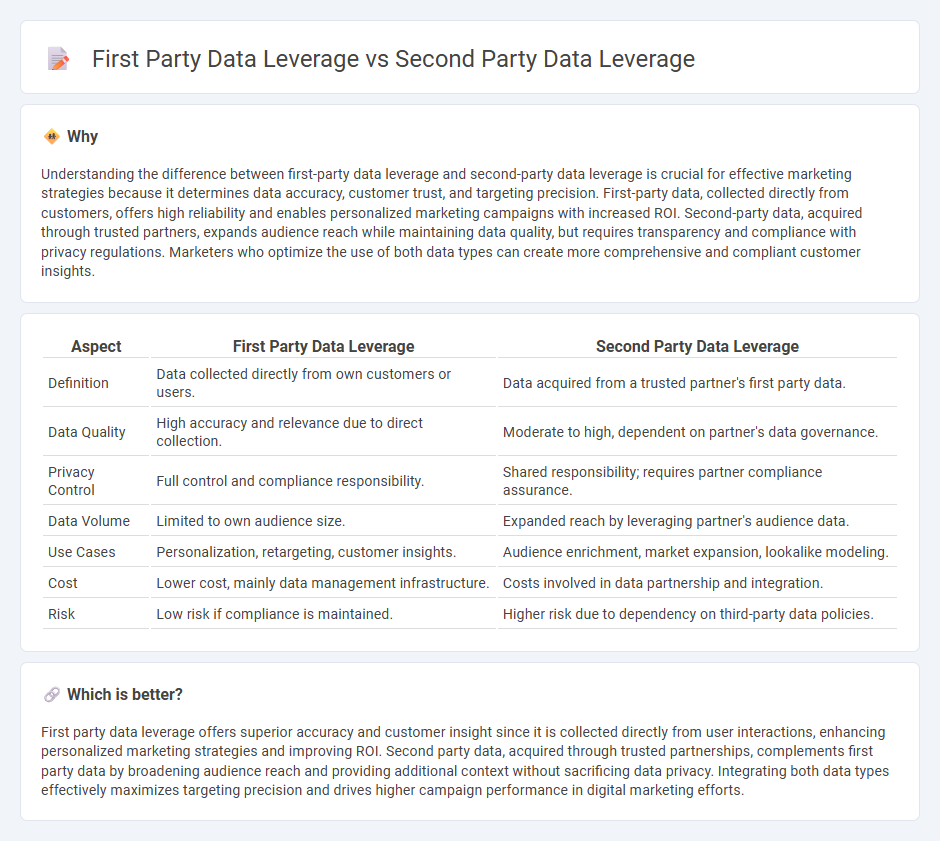
First-party data offers businesses direct access to consumer information collected through their own channels, ensuring accuracy and enhanced personalization in marketing strategies. Second-party data involves sharing data between trusted partners, expanding audience reach while maintaining quality and compliance standards. Explore how leveraging these data types can transform your marketing effectiveness and customer engagement.
Why it is important
Understanding the difference between first-party data leverage and second-party data leverage is crucial for effective marketing strategies because it determines data accuracy, customer trust, and targeting precision. First-party data, collected directly from customers, offers high reliability and enables personalized marketing campaigns with increased ROI. Second-party data, acquired through trusted partners, expands audience reach while maintaining data quality, but requires transparency and compliance with privacy regulations. Marketers who optimize the use of both data types can create more comprehensive and compliant customer insights.
Comparison Table
| Aspect | First Party Data Leverage | Second Party Data Leverage |
|---|---|---|
| Definition | Data collected directly from own customers or users. | Data acquired from a trusted partner's first party data. |
| Data Quality | High accuracy and relevance due to direct collection. | Moderate to high, dependent on partner's data governance. |
| Privacy Control | Full control and compliance responsibility. | Shared responsibility; requires partner compliance assurance. |
| Data Volume | Limited to own audience size. | Expanded reach by leveraging partner's audience data. |
| Use Cases | Personalization, retargeting, customer insights. | Audience enrichment, market expansion, lookalike modeling. |
| Cost | Lower cost, mainly data management infrastructure. | Costs involved in data partnership and integration. |
| Risk | Low risk if compliance is maintained. | Higher risk due to dependency on third-party data policies. |
Which is better?
First party data leverage offers superior accuracy and customer insight since it is collected directly from user interactions, enhancing personalized marketing strategies and improving ROI. Second party data, acquired through trusted partnerships, complements first party data by broadening audience reach and providing additional context without sacrificing data privacy. Integrating both data types effectively maximizes targeting precision and drives higher campaign performance in digital marketing efforts.
Connection
First party data leverage enhances personalized marketing strategies by collecting direct customer insights, while second party data leverage expands audience reach through trusted partnerships sharing their first party data. Combining both data types optimizes customer profiling, enabling precise targeting and improved campaign performance. Integrating first and second party data creates a robust data ecosystem that drives higher engagement and conversion rates.
Key Terms
Data Ownership
Second party data leverage involves acquiring data through direct partnerships, allowing businesses to access external customer insights while maintaining shared data ownership agreements. First party data leverage centers on collecting and utilizing data directly from a company's own customers, ensuring complete data ownership and control over privacy compliance. Discover how maximizing data ownership strategies can enhance your marketing precision and customer trust.
Data Accuracy
First party data leverage ensures higher data accuracy because it is collected directly from customer interactions, providing precise and relevant insights. Second party data leverage depends on data sharing between trusted partners, which can introduce variability in data quality and consistency. Explore our detailed analysis to understand how data accuracy impacts marketing strategies.
Audience Reach
Second-party data leverage expands audience reach by accessing partner-collected data, providing enriched insights beyond a brand's direct interactions. First-party data leverage focuses on highly accurate and privacy-compliant information directly gathered from a brand's own audience, ensuring precision in targeting. Discover how these data strategies can optimize your audience engagement effectively.
Source and External Links
What is Second-Party Data in Business? - Leveraging second-party data enhances businesses by providing deeper insights and more effective strategies through trusted partnerships.
What Is Second-Party Data, and How Does It Fit Into Data Strategies? - Second-party data offers a collaborative approach to data collection, providing valuable insights into customer behaviors and preferences.
What is Second Party Data vs First Party - Examples - Second-party data is used to minimize risk and provide targeted customer experiences, offering better data quality and deeper targeting compared to third-party data.
 dowidth.com
dowidth.com